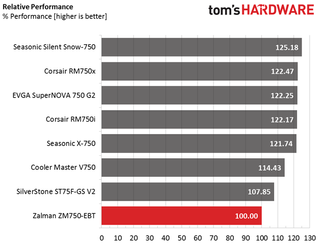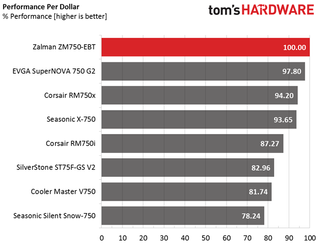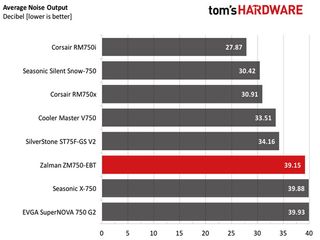Zalman ZM750-EBT PSU Review
Zalman's new EBT line consists of four PSUs ranging from 650W to 1kW capacity. Today, we're testing the ZM750-EBT, which, thanks to a low price, achieves a good value score. But how does it fare in terms of absolute performance?
Why you can trust Tom's Hardware
Performance, Performance Per Dollar, Noise and Efficiency Ratings
Performance Rating
The following graph shows the PSU's total performance rating, comparing it to other units we've reviewed. To be more specific, the tested unit is shown as 100 percent, and every other product's performance is shown relative to it.

The ZM750-EBT's performance is poor; it can't even match SilverStone's ST75F-GS V2, which is based on the same platform. Compared to the rest of the competition in this category, the difference is huge (and not in a good way).
Performance Per Dollar
The following chart may be the most interesting to many of you because it depicts the unit's performance-per-dollar score. We looked up the current price of each PSU on popular online shops, using those prices and all relative performance numbers to calculate the index. If the specific unit wasn't available in the United States, we searched for it in popular European Union shops, converting the listed price to USD (without VAT). Note that all of the numbers in the following graph are normalized by the rated power of each PSU.

Thanks to its low price, the ZM750-EBT finds itself in a very good place on this chart. Personally, though, I'd rather spend a few more bucks to get a PSU with a longer hold-up time and better ripple suppression.
Noise Rating
The graph below depicts the cooling fan's average noise over the PSU's entire operating range, with an ambient temperature between 28 and 30 °C (82 to 86 °F).

This is a noisy PSU, and under tough operating conditions it will annoy most users. If you plan to build a quiet system, avoid the ZM750-EBT.
Efficiency Rating
The following graph shows the average efficiency of the PSU throughout its entire operating range, with an ambient temperature between 28 and 30 °C.

In this graph, the ZM750-EBT surpasses the performance of Corsair's RM750x and RM750i. However, those power supplies feature much better ripple performance, tighter load regulation, higher hold-up time and quieter fans. The only downside is that they cost more.
Current page: Performance, Performance Per Dollar, Noise and Efficiency Ratings
Prev Page Ripple Measurements Next Page Pros, Cons And Final VerdictStay On the Cutting Edge: Get the Tom's Hardware Newsletter
Join the experts who read Tom's Hardware for the inside track on enthusiast PC tech news — and have for over 25 years. We'll send breaking news and in-depth reviews of CPUs, GPUs, AI, maker hardware and more straight to your inbox.
Aris Mpitziopoulos is a Contributing Editor at Tom's Hardware US, covering PSUs.
-
Onus Although the article does mention safety, a very valid point, it still managed to imply that a single-rail PSU was "better" due to the complexity of managing rail assignments so as to not trip OCP protections. I've have not seen a multi-rail PSU actually get dinged for this in a review for maybe 8-10 years; it seems that everyone does OCP "right," so this is no longer an issue, ever. That being the case, the greater safety of a multi-rail design is superior.Reply
I'll need to make at least another pass through this article, but failing on +5V ripple under heavy load probably makes this a solid tier-3 unit; I'm not going to run screaming if I see one, but I wouldn't buy it either. -
JQB45 Tier-3 might be generous. There were a lot of cons. What good is a 7 year warranty if the PSU takes something else out in addition to the PSU.Reply
CONS: Ripple • Noisy under stress • Hold-up time • Inrush current • Sleeve-bearing fan • Single EPS connector • Inaccurate PWR_OK signal
Also it must also be strongly pointed out that this unit does not meet ATX specifications. -
Onus True, but the tier-3 units are the ones considered solid for lighter loads. Those cons are why I certainly would not buy one for a gaming or rendering rig, but for the typical PC that may not need even half this power, I wouldn't worry about it.Reply -
Sakkura The fact that it's not just barely breaking the ATX spec at 100% load, but already starts to go out of spec at 80% and then has two rails well out of spec at 100%, is what makes this a tier 4 unit, and a clear "do not buy" regardless of price.Reply -
yyk71200 One would expect that a gold rated powersupply would be at least a solid unit and a safe buy. Guess not. Shouldn't buy one simply based on advertised efficiency rating.Reply -
Onus That's definitely true. Coolermaster taught that lesson quite well.Reply
Hmmm, this one does seem a little worse than I thought at first. Any chance this particular unit had a problem? I'd think ripple could be fixed with a minor capacitor improvement, without adding too much to the price. Hopefully Zalman is paying attention. -
JQB45 Reply17328110 said:That's definitely true. Coolermaster taught that lesson quite well.
Hmmm, this one does seem a little worse than I thought at first. Any chance this particular unit had a problem? I'd think ripple could be fixed with a minor capacitor improvement, without adding too much to the price. Hopefully Zalman is paying attention.
agreed -
COLGeek It is interesting to see Zalman developing this line of PSUs. Hopefully, they will be better than previous generations. Had a couple Zalman PSUs a few years ago, when I used to use Zalman heatsinks.Reply
One died days after the warranty expired and the other about a month after. I'll give Zalman credit, they made right by me by exchanging both, but it was a painful process.
While I would not recommend these current products, I can at least "tolerate" them in budget builds. -
turkey3_scratch I would think anything out of spec should be Tier 4. Ripple is trash. 3.3V rail was on the brink of being out of spec. 12V was also quite terrible at 90mv.Reply
Anyway, I like your power supply reviews, Toms. You go more in-depth than any review site for power supplies (Hardwaresecrets, Johnnyguru). -
Sakkura Reply17328110 said:That's definitely true. Coolermaster taught that lesson quite well.
Hmmm, this one does seem a little worse than I thought at first. Any chance this particular unit had a problem? I'd think ripple could be fixed with a minor capacitor improvement, without adding too much to the price. Hopefully Zalman is paying attention.
Considering the same platform performs decently in the Silverstone unit, there's at least some hope that Zalman can go back, adjust a few things, and get a decent budget unit out of this.
Edit: I went back and looked at the Silverstone review. Ripple suppression was really good up to 90% load, then the 5V and 3.3V rails jumped hugely, especially the 3.3V. They did stay within ATX spec, but just barely. The 5V ripple went from 13.1mV at 90% to 40.5mV at 100%, 3.3V ripple went from 14.1mV at 90% to 49.9mV at 100%. Obviously the 3.3V ripple went out of spec at 110% load, as well as one of the crossloads, but that's a lesser sin.
